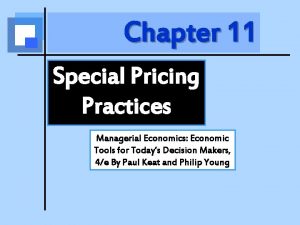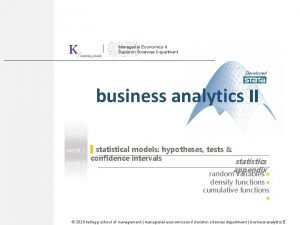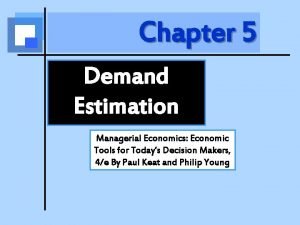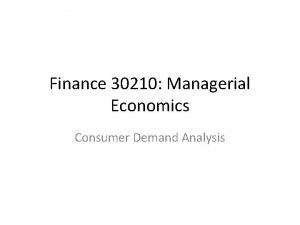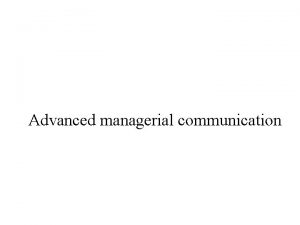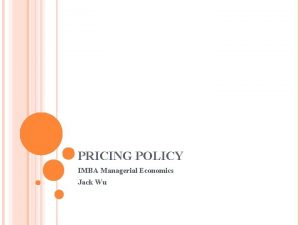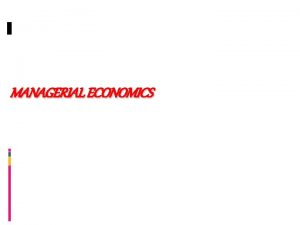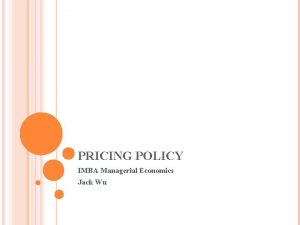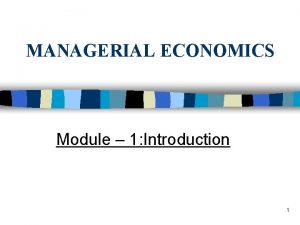Advanced Pricing Managerial Economics Kyle Anderson Additional pricing



















- Slides: 19

Advanced Pricing Managerial Economics Kyle Anderson

Additional pricing strategies • • • Complementary product pricing Two part pricing Peak-load pricing Bundling Block pricing • Implementing pricing strategies Kyle J. Anderson

Sports pricing • Elasticity of demand estimates of sporting events indicate that the own price elasticity of demand is -0. 9. Can this be profit-maximizing? Kyle J. Anderson

Complementary Pricing P 100 TR Unit elastic Elastic Unit elastic 1200 60 Inelastic 40 800 20 0 10 20 30 40 50 Q 0 10 20 30 40 MR MR Kyle J. Anderson Elastic Inelastic 50 Q

Complementary Pricing • If you sell multiple products that are complements, it is profit maximizing to sell one or more products below the otherwise profit maximizing price. • Foregone profits on one lead to higher sales (and profits) on other product(s). • Sometimes called a loss leader. • Discounted product should be more “visible. ” • A few legal concerns. Kyle J. Anderson

Kyle J. Anderson

Movie Pricing problem • Frequent movie-goers have a demand curve of Q=8 -1/2 P (Assume MC=0 (not true!) and ignore complementary products). • Monopoly (or MC) pricing: • P=16 – 2 Q • MR = 16 – 4 Q, MC = 0 • Q = 4, P = $8 • Profit per customer $32 Kyle J. Anderson

Monopoly pricing Price P = 16 – 2 Q MR = 16 – 4 Q Q=4, P=$8 16 Monopoly Profits = $32 D Kyle J. Anderson 8 MC Quantity

Two part pricing Price 1. Set price at marginal cost. 2. Compute consumer surplus. 3. Charge a fixed-fee equal to consumer surplus. 16 Fixed Fee = Profits* = $64 D Kyle J. Anderson 8 MC Quantity

Both Monopoly and Two part pricing Price 16 1. 2. 3. 4. Set price at marginal cost. Compute consumer surplus. Calculate CS under monopoly ($16) Charge a fixed-fee that leaves enough CS for customers to choose that option. Fixed Fee = $32 - $48 No Deadweight Loss D Kyle J. Anderson 8 MC Quantity

Two Part Pricing • Potential gains for both consumers and sellers. • Works when consumers have similar demand curves. • Subscription services may work: (Netflix, utilities) Kyle J. Anderson

Peak-Load pricing • When demand during peak times is higher than the capacity of the firm, the firm should engage in peak-load pricing. MC Price PH DH PL MRH • Charge a higher price (PH) during peak times (DH). • Charge a lower price (PL) during off-peak times (DL). MRL QL Kyle J. Anderson DL QH

Kyle J. Anderson 05 December 2020

Kyle J. Anderson

Other Pricing Strategies • • • Bundling Block Pricing Penetration pricing Price signaling Reference pricing Kyle J. Anderson • Economies of Scale • Brand loyalty • Experience Curve

Fairness in pricing - Is this fair? A hardware store has been selling snow shovels for $15. The morning after a large snowstorm, the store raises the price $20. Please rate this action as: completely fair, acceptable, unfair, or very unfair. 82% of respondents view this as unfair or very unfair. Kyle J. Anderson

What determines a fair price? • Economic/Business point of view • Expectations • Social norms – Price increases should be due to cost changes, not changes in demand. – Loyal customers should get a discount. – Buying in volume should lead to lower per-unit prices. – Some items should be free Kyle J. Anderson

Strategies for price discrimination & price changes • Make it invisible. (Carefully) • Make it conform to social norms (i. e. discounts for certain groups. ) • Frame differential pricing as discounts rather than a price premium. • Justify price changes by cost changes. • Use inventory strategies to charge differential pricing. (But don’t bait and switch) Kyle J. Anderson

Kyle’s Managerial Economics • Books: – The Art of Strategy (Game Theory Bible) – Why Popcorn Cost So Much at the Movies (pricing) – The Informant (Price fixing, Cournot) – The Winners’ Curse (General economics) – Predictably Irrational (Behavioral economics) – Switch (Personal and Organizational Change) • Podcasts: – Planet Money Kyle J. Anderson
 Transfer pricing in managerial economics
Transfer pricing in managerial economics Pricing practices in managerial economics
Pricing practices in managerial economics Game theory managerial economics
Game theory managerial economics Managerial economics and decision sciences
Managerial economics and decision sciences What is demand forecasting and estimation
What is demand forecasting and estimation Managerial economics applications strategy and tactics
Managerial economics applications strategy and tactics Demand estimation in managerial economics
Demand estimation in managerial economics Nature of managerial economics
Nature of managerial economics Methods of cost estimation in managerial economics
Methods of cost estimation in managerial economics Managerial economics
Managerial economics The firm and its goals
The firm and its goals Aggregative
Aggregative Managerial economics 12th edition mark hirschey
Managerial economics 12th edition mark hirschey Managerial economics demand analysis
Managerial economics demand analysis Risk and uncertainty in managerial economics
Risk and uncertainty in managerial economics Nature and scope of macro economics
Nature and scope of macro economics Profit management in managerial economics
Profit management in managerial economics Managerial economics
Managerial economics Managerial economics is called as
Managerial economics is called as Explain the fundamental concepts of managerial economics
Explain the fundamental concepts of managerial economics

